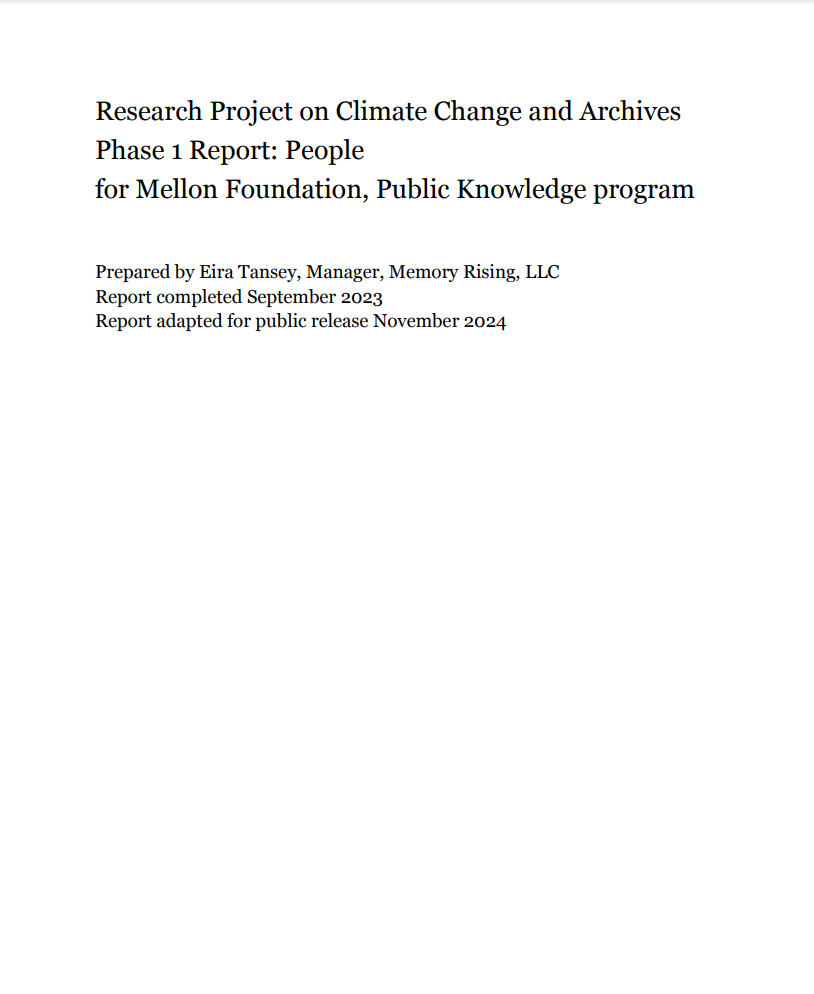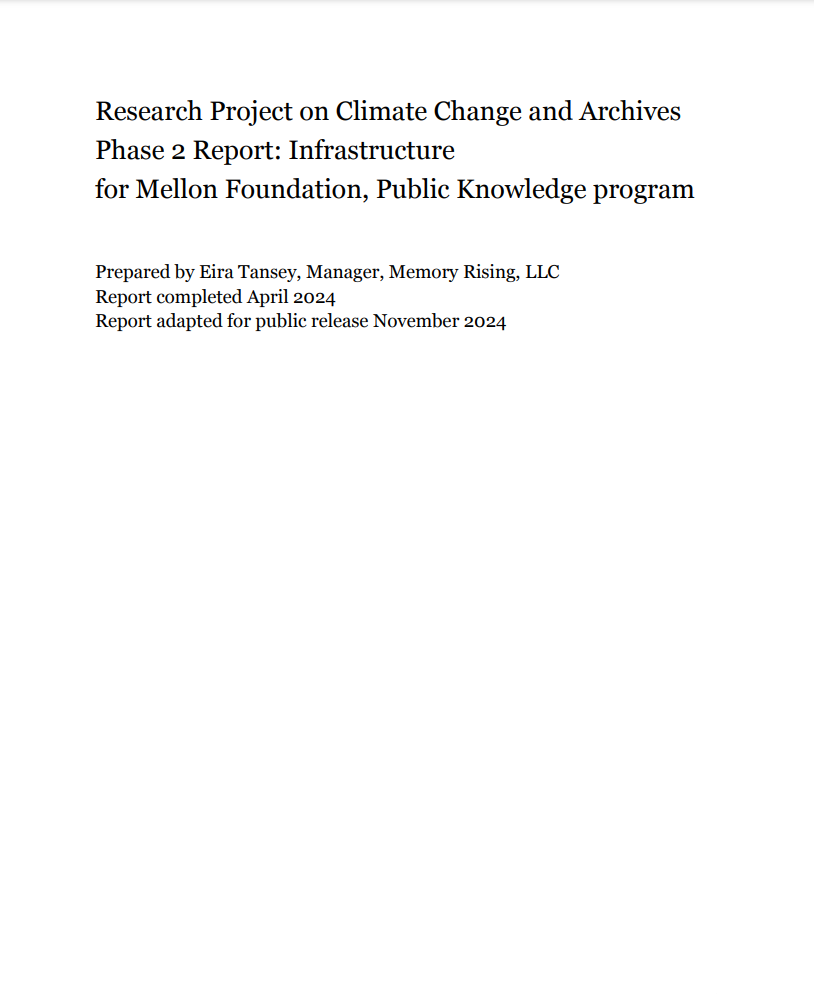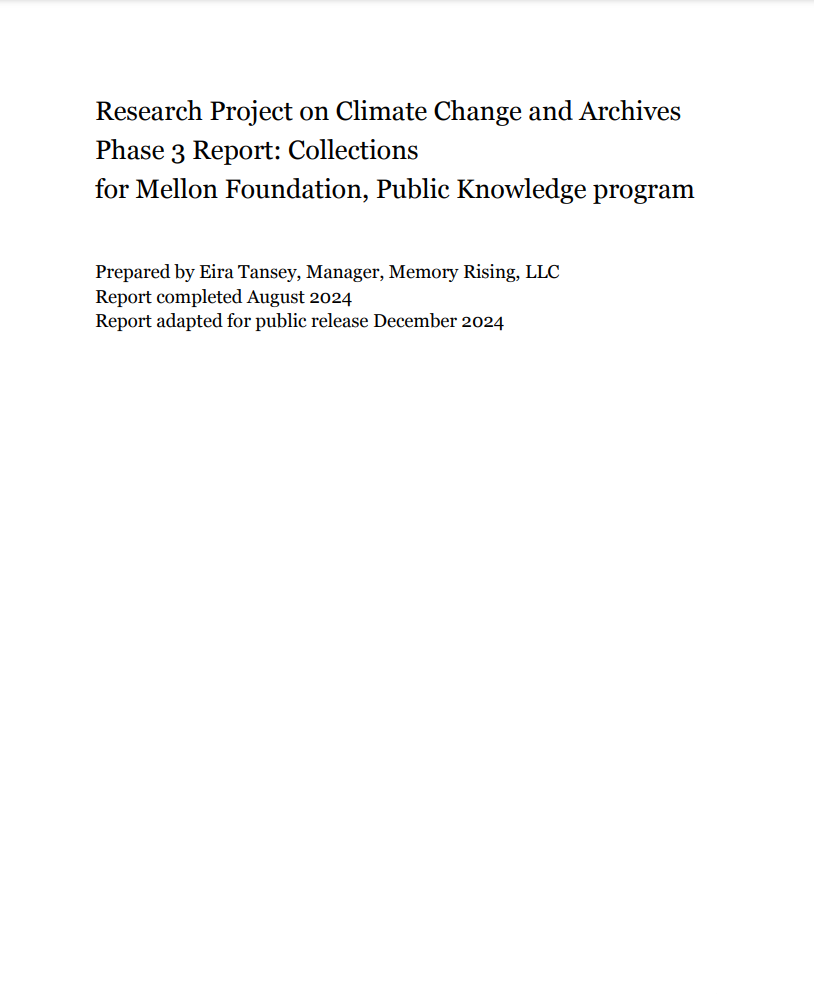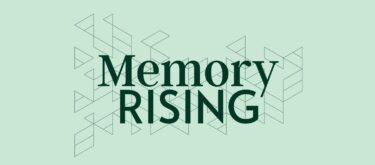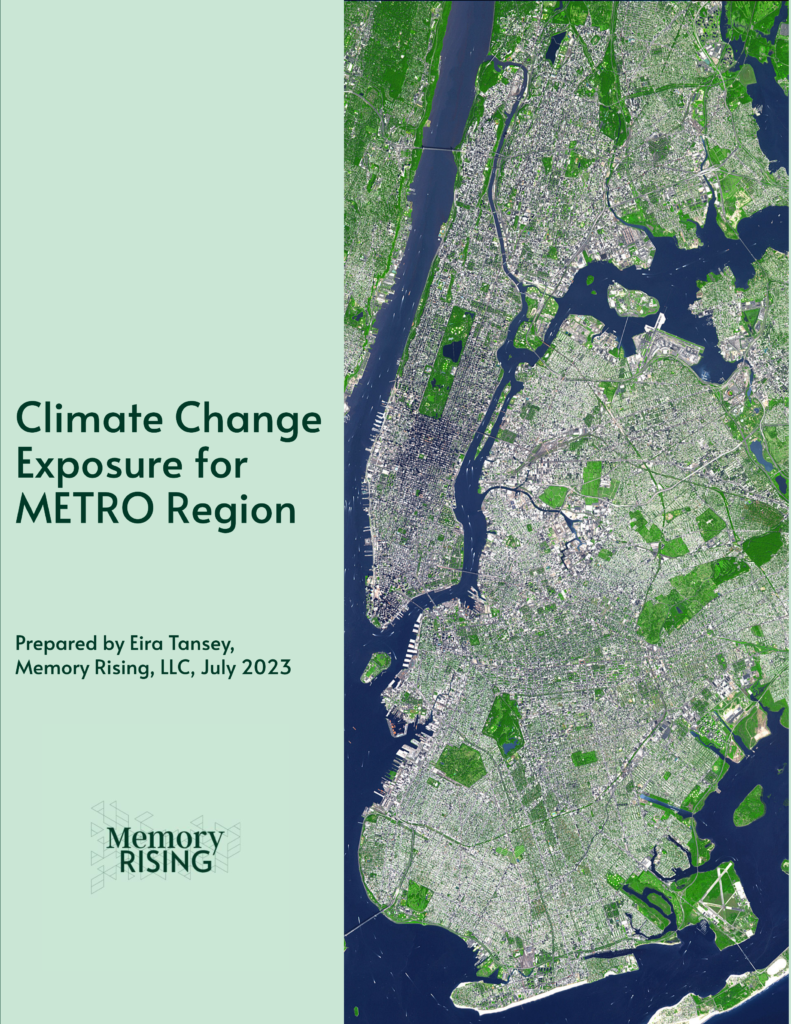The following case study is adapted from the comprehensive Phase 2 (Infrastructure) report prepared for the Public Knowledge program of The Andrew W. Mellon Foundation as part of a larger eighteen-month research project on archives and climate change.
Emergency preparedness and disaster response is increasingly urgent for archives across the country. With climate change impacting every corner of the United States, there are increasingly severe disasters. According to the National Climate Assessment:
In the 1980s, the country experienced, on average, one (inflation-adjusted) billion-dollar disaster every four months. Now, there is one every three weeks, on average. Between 2018 and 2022, the US experienced 89 billion-dollar events. Extreme events cost the US close to $150 billion each year—a conservative estimate that does not account for loss of life, healthcare-related costs, or damages to ecosystem services.1
It is no longer a question of if archives will experience an emergency or disaster, but when and on what scale. While cultural heritage professions have devoted increasing resources and attention to emergency preparedness thanks to several pivotal events of the last several decades, American archives are still lagging in full preparation for a variety of emergencies.
The Institute of Museum and Library Services Heritage Health survey found that 42% of US collecting institutions have an emergency/disaster plan, and archives were the most likely type of institution (52%) to have a written plan. However, there are major differences within archives based on size: 86% of medium/large archives have some kind of emergency/disaster plan, but only 47% of small archives report the same. Only 24% of US collecting institutions have both a plan and trained staff, however archives were the most likely type of institution to have a written plan and trained staff.2
The Association of Tribal Archives, Libraries, and Museums’s 2021 survey found 57% of tribal archives have disaster preparedness plans.3 The Council of State Archivists has recently found that a majority of state archives have an emergency plan, but a majority of respondents “rarely” or “never” practice these plans. Natural disasters are the most frequently identified risk in continuity of operations planning (other types of risks include civil disturbance, pandemics, mass shootings, and arson), and 34% of respondents participate in a regional cultural heritage emergency preparedness organization.4
As of today, there is no comprehensive national strategy that exists to support the emergency preparedness needs of all archives. Emergency preparedness often comes down to what local resources are available, the knowledge and commitment of leaders, and the organizational positioning of archives. For example, an archive in a large university library may have access to emergency response officials, while a small community archive might not.
There are uneven resources for archives that need external disaster response support. The Society of American Archivists maintains a National Disaster Recovery Fund for Archives, which makes small grants to archives facing disasters. Other resources like the American Institute for Conservation’s National Heritage Responders may assist archives with hands-on support during major disasters. Getting the word out about organizations that can provide assistance is crucial since many smaller archives are not as well networked into large archival associations. On the other hand, these resources are limited and cannot always scale for a major disaster affecting many archives. Organizations that face major disasters often need to navigate FEMA’s Public Assistance process.
As the insurance industry increasingly reacts to climate change by raising rates and even pulling out of markets, this will have implications for archives. The art museum sector is already grappling with this issue, as museums in vulnerable coastal areas find their insurance premiums are increasing or their coverage is reduced.5 Like art museums, the contents within archives are unique. But unlike museums, there is a limited “market” for archives, and this makes financial appraisals of archival collections difficult. Large archives in governments (which are often self-insured) or major universities are likely covered by their parental organization’s insurance policies, but small independent community archives, historical societies, and standalone nonprofit archives may face the greatest risk from the fluctuating insurance market.
Education and Training
Since emergencies of many kinds are likely to be faced by most archivists over the course of their careers, this makes education and ongoing professional development in this area critical for the ongoing stewardship of collections. Some subject matter experts expressed concern about the lack of training for graduate students. This educational gap is also reflected within the Society of American Archivists’ Guidelines for a Graduate Program in Archival Studies (GPAS). Despite being revised in 2023, the GPAS guidelines do not mention education or training related to emergencies and disasters. Given the climate crisis and how many archivists work in small institutions in which they may be a “lone arranger” (i.e. a solo archivist), it is a serious concern that emergency preparedness and disaster response is not a core part of graduate archival education.6
One subject matter expert noted that disaster training should incorporate local conditions and risks. For example, many traditional disaster response training workshops that originate in the Eastern half of the United States involve wet salvage exercises to mimic responding to a flood or other water event. However, in the US West, there is an urgent need for training related to responding to soot and fire-damaged items following a wildfire.
Being able to participate in ongoing professional development related to emergency preparedness and disaster response is essential for archivists’ capacity to address these issues, especially including updating emergency plans to keep up with new approaches to disaster response. Each new major disaster brings new lessons learned in effective disaster response. Early disaster response training for cultural heritage was influenced by events such as the 1966 Florence floods and the 1973 National Archives St. Louis National Personnel Records Center fire. More recent disaster response training has incorporated lessons learned from the September 11th terrorist attacks and major hurricanes like Hurricane Katrina, Hurricane Sandy, and Hurricane Maria.
Importance of Networks
Emergency preparedness and disaster response networks are groups intended to promote planning for participants prior to an emergency/disaster, and facilitate resources and communications during and after an emergency/disaster. Ideally, these organizations also help build relationships between emergency management officials and cultural heritage professionals. These groups are a vital resource to assist smaller and more vulnerable archives. However, like all professional associations, their success depends disproportionately on a small number of enthusiastic and committed individuals.
The Heritage Emergency National Task Force formed in 1994 and was one of the first major national networks dedicated to coordinating communications and resources between the emergency management and cultural heritage communities.7 Since 2000, dozens of other similar organizations have formed at the state and local levels. Most of these networks have affiliated under the larger umbrella of the Alliance for Response, which is currently managed by the American Institute for Conservation. The Alliance for Response website currently maintains links to over 30 state and local networks.8 However, since these organizations are largely self-directed, there is wide variation in their activity levels.
Assessing Disaster Losses
Even as disasters become increasingly frequent and severe, it is hard to assess the amount of damage incurred among US cultural heritage institutions. Since there is not a central reporting mechanism for American archives, there is not a way to quantify cumulative loss each year among archives. Some archives publicly share about disasters when they happen, but many do not.
Publicly available post-disaster reports are often limited to institutional case studies. For example, much of the literature around Hurricane Katrina’s impacts on libraries focuses on the recovery efforts at specific libraries. This means it is difficult to understand the total impacts of a major disaster that affects a large area. However, there is at least one example of a major disaster assessment that can serve as a model for analyzing widespread damages.
The 2002 report, Cataclysm and Challenge: Impact of September 11, 2001, on our Nation’s Cultural Heritage, serves as a model for the kind of post-disaster cross-institutional reporting that would be very useful to the archives profession in the wake of major disaster.9 The report was sponsored by the now defunct organization Heritage Preservation along with the Heritage Emergency National Task Force, and conducted the month following the September 11, 2001 terrorist attacks. Combining news reports with a survey, the report described the breadth of the damages, highlighted some of the major losses (like the Helen Keller Foundation which contained many of her papers), and provided information about how organizations responded as the terrorist attacks unfolded and in the subsequent disaster recovery process.
Conclusion
Infrastructure issues are affected by larger workforce issues. Resource and funding issues have a large impact on both personnel and infrastructure. This means there are major institutional disparities between those who can mobilize for climate change adaptation and those who are falling further behind. Organizations that are unable to maintain professional full-time permanent staff are also the same organizations that often have severe infrastructure issues. We also know the least about these organizations due to their distance from professional networks. Additionally, people are an essential component of maintaining and monitoring infrastructure issues.
Unlike personnel issues, infrastructure issues in archives have more funding sources, mutual aid networks, and widely accepted best practices and guidelines. However, small institutions don’t always have the capacity to take advantage of these resources, and larger institutions often do not want to take the risk of trying something new. In several interviews, subject matter experts stressed the importance of bottom up pressure to shift leadership towards embracing new best practices and emergency planning. It’s clear that when it comes to infrastructure issues, people remain an important part of supporting and strengthening these vital systems.
Sources
American Institute for Conservation. “Alliance for Response Networks.” Accessed January 22, 2024. https://www.culturalheritage.org/resources/emergencies/alliance-for-response/networks
Cooper, Madeline, and Madeline Hagerman. “A Brief History of Emergency Programming at Heritage Preservation.” Accessed January 22, 2024. https://www.heritagepreservation.info/emergency-programs
Council of State Archivists. “The State of State Records,” September 2023. https://www.statearchivists.org/viewdocument/2023-the-state-of-state-records-a
Hargraves, Ruth. “Cataclysm and Challenge: Impact of September 11, 2001, on Our Nation’s Cultural Heritage.” Heritage Preservation, Inc., 2002. https://resources.culturalheritage.org/cataclysmandchallenge/wp-content/uploads/sites/16/2017/06/Cataclysm.pdf
Ho, Karen K. “Growing Claims from Climate Change Will Prompt Art Insurance Rate Increases, Experts Report.” ARTnews.Com (blog), November 30, 2022. https://www.artnews.com/art-news/news/art-insurance-price-increases-climate-change-1234646985/
Institute of Museum and Library Services. “Protecting America’s Collections: Results from the Heritage Health Information Survey, February 2019.” Washington DC, 2019. https://www.imls.gov/sites/default/files/publications/documents/imls-hhis-report.pdf
Jorgensen, Miriam, and Britnee Johnston. “Chapter 1. Tribal Archives.” In Sustaining and Advancing Indigenous Cultures: Field Surveys and Summits, 2021. Oklahoma City, OK: Association of Tribal Archives, Libraries, and Museums, 2022. https://www.atalm.org/resources/reports/atalm-reports/#tribal-archives-needs-assessment-report/2/
Society of American Archivists. “Guidelines for a Graduate Program in Archival Studies,” 2023. https://www2.archivists.org/sites/all/files/Guidelines%20for%20a%20Graduate%20Program%20in%20Archival%20Studies.pdf
U.S. Global Change Research Program. “Chapter 1: Overview.” In Fifth National Climate Assessment. U.S. Global Change Research Program, 2023. https://doi.org/10.7930/NCA5.2023.CH1
